What makes a healthy space? Hint: It’s more than the indoor air quality - by Maia Gilman

The Falcon Group
Have you ever walked into a space and felt uplifted by it? What makes that happen–is it your mood, your expectation, or is it the space itself? It may be a little of all those factors, and all are related. We are connected creatures, and our moods and reactions can be as changeable as our interactions with one another. When we walk into a space, are we picking up on the existing mood of the place, or are we projecting our own? I think it’s a bit of both. Our mood predetermines what experience we are more likely to match up with. And this affects our experience of a space.
I’ve seen this time and time again with architecture clients: once I do a deep dive with a client into their space planning needs, this underlying mood becomes even more apparent. Part of my job as an architect is to help clients attune to the mood they want to evoke, both inside themselves, inside their guests and clients, and in the spaces we are designing for their programmatic activities.
What is a person’s expectation when they walk into a space? Often, it is to find success in an encounter; to find something to buy, to conduct an intended rendezvous, or to enjoy a particular type of experience. Does a person have a preconceived idea of the outcome of their encounter in the space? Possibly, and as an architect, I don’t control that. I can, however, design for a more powerful likelihood of a positive outcome, by designing a healthy space, intentionally.
What is a healthy space, by my definition? It includes the elements wrapped into LEED, Green Globes and the Living Building Challenge, among other systems. It can be designed to Passive House standards, soon to be a more common backbone of our building codes. These standards guide architects in considerations of indoor air quality, resource management, material selections, and more.
But does including these items ensure a healthy-feeling space, or is there more to it? Does LEED guarantee a happier and more positive space, creating a tableau for an uplifted mood and an expectation of a good outcome? On some level, I think it does. We expect a “green” building to “feel” better as well as to function more efficiently.
My experience in visiting all types of LEED-certified buildings is that they do, indeed, have a breathy and expansive quality that is exciting. That is certainly a subjective way to describe an experience of a set of engineering systems, but if you will indulge my subjectivity for a moment, you will see where I am going with this.
I once had the opportunity to hold a meeting between my client (a yoga studio owner) and a contractor (HVAC was his specialty). We had a technical discussion about much more than the currents of the air, as understood by the contractor; we also brought in a discussion of the yoga studio owner’s appreciation of prana, or breath, as defined by yoga. To tie it all together, I brought up the feng shui concept of chi, or energy flow.
What resulted was a shared approach to designing the space that reflected all three perspectives including the HVAC air flow calculations, the prana expression, and the chi flow, into a space that by all accounts is vibrant, healthy and that sets a positive mood, enabling visitors to find their encounters to be uplifting. What made this design experience different? It started with the intention behind the design project. And that’s not something prescribed by typical building rating systems.
In an older existing building, as we often engage with in Falcon’s projects in restoration and adaptive reuse, it is typical to find a mix of old materials, past tenants, and unwanted guests. I am frequently asked by clients about the energy of a space that is left by an earlier building use, or by a previous group of people. After many years of experience and practice with this, in buildings ranging back to the 1600s in North America, I have come up with this approach to making an old space feel new again: focus on the healthy flow you want to achieve in the space. Forget all the other stuff. You will find a quicker and more lasting positive shift to lean in the direction you want to go.
How can you find that healthy flow in your own projects, beyond employing the guidelines of LEED and so on? The programming phase of a project is an important time for an architect to take the emotional temperature of the client and the project. What direction do you wish to go? Find the strength in the project and the space and go from there. Engage the client in diagramming and mapping ideas and functionality flows. What are the natural assets of the space, that come from a predisposition to an appreciation of natural light, interesting views, and a sense of mastery of one’s environment? Where are the bright corners that you can work to amplify, and where can you make changes to increase a sense of vitality through connecting with natural light and views?
What color families is the client drawn toward, in your conversations and meetings? Is it brand or logo colors, and do those brand colors still represent where the client wants to go? Take the opportunity to tune in on color, early on. Invest time in exploring color with the client. What makes the client really radiate well in the space? What makes the business idea really pop out and make a positive impression? This is important for the architect to be involved with as a core principle.
Engage a playful approach to geometry and proportion, recognizing that the human body has a natural fit with certain pre-existing proportions in nature. Look to the Fibonacci series for inspiration: this is the mathematical basis for the spiraling forms you will find throughout nature, ranging from the structure of a cell to the patterns of planetary movements around us. We have a tendency to feel comfortable in spaces designed to these proportions. This can be as simple as employing a rectangular golden section form in a plan diagram, or as complex as restoring a rose window detailed in stained glass.
Bring in a balanced sense of materiality and natural elements. Is the client drawn to sharp metallics? Balance this with wood and fiber. Is the client drawn to polished concrete? Bring in a green living wall. Find a harmony between the natural elements that are easily available to designers and developers, without adding undue cost burdens to the project. Tune into the idea of biophilia, or the tendency to affiliate with natural elements.
Focus on the direction you want to guide the client and the client’s visitors. If you want to create an essence of health, bring in those attributes that magnify well-being, such as structuring a storytelling approach in design, appreciating existing opportunities of light, tuning into color and taking a playful approach to spatial proportions. While we don’t control the moods and expectations of others, we do control the physical environment into which we invite them.
Maia Gilman, RA, LEED-AP BD+C, is a senior achitect at The Falcon Group, Bridgewater, N.J.
Troutbrook expands with boutique condo project and Marriott Fairfield Inn & Suites renovation








.gif)
.jpg)

.gif)